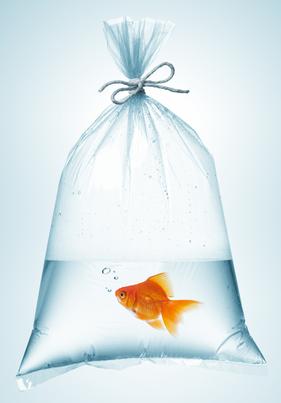| Back to Back Issues Page |
 |
|
The Goldfish Gazette, Issue #113 Un-bagging new fish May 28, 2023 |
Goldfish Care TipsA Free Monthly Resource For Goldfish Enthusiasts In This Issue With the increasing popularity of ordering fish on-line, the importance of knowing how to un-bag fish that have traveled for some time sealed in a plastic bag is critical to avoid life threatening changes in water conditions when a bag is unsealed. Un-bagging New Fish The problem is one of ammonia build up.
The problem is one of ammonia build up.
My e-Zine no.108 (The Ammonia Test) explained how test kits measure total ammonia which is made up of toxic and non-toxic elements, and how water temperature and pH must be used to calculated how much of each is present. When un-bagging new arrivals, the owner must be aware of how the un-bagging process can affect the amount of toxic ammonia in the bag. Water Conditions in the Bag on ArrivalThe fish have been producing ammonia and carbon dioxide during the journey. The dissolved carbon dioxide creates carbonic acid which drops the pH. This drop in pH is what allows fish to travel for long periods of time in a small amount of water.The water temperature may be quite low due to ice packs being included in the polystyrene shipping box. These two factors mean the amount of toxic ammonia in the bag is low. What Not to DoWe know high pH and high water temperatures increase the amount of toxic ammonia when ammonia is present.Your prepared quarantine tank water will have a pH of around 7-7.4, and may be a lot warmer than the water in the bag. If you float the bag in the quarantine tank, you are increasing the water temperature. If you add water to the bag from the quarantine tank, you are raising the pH. Both these actions increase the amount of toxic ammonia in the bag, dramatically. Raising the pH from 6.0 to 7.0 raises the amount of toxic free ammonia gas into the water 10-fold. What you Should DoThe way to avoid subjecting your new fish to an ammonia spike is to rapidly open the bag, pour the fish and water into a net, and place the fish into the quarantine tank.This method is called the cut (the bag), pour (the contents into a net), plop (the fish into the quarantine tank). It is now widely recognized as the safest method of removing fish from a shipping bag. Even un-bagging fish from a local fish store purchase could prove dangerous for the fish. If the water hasn’t been changed at the store for a while, the pH will probably be low. If for some reason there has been a buildup of ammonia in the store tank, the water in the bag containing your new fish may be the same as for a fish that has traveled over several days. Your fish will be giving off ammonia anyway, and depending on how many fish are in the bag, ammonia levels could be quite high even after an hour. I would still use the cut, pour, plop method for local purchases. Quarantine Tank PreparationYour new fish will have been highly stressed for some days. Stress leads to a weaken immune system which often leads to illness.The high levels of carbon dioxide in the bag water reduce the oxygen carrying ability of the fish’s blood. The water in the quarantine tank should be well aerated, but not so aerated that the fish is fighting against a strong current. Sponge filters are good for this as the uplift tubes are close to the surface causing good surface agitating without creating a strong water current. I always add a small amount of salt, about one tablespoon per two gallons. This boosts the fish’s immune system. If there is evidence of pathogens present, I increase this to one tablespoon per gallon which will treat 90% of Goldfish illnesses. I also add a parasite control medication that contains Praziquantel. This will treat flukes and internal worms and some protozoan parasites. If the water temperature will be below 20oC (68oF), I will heat the water. At temperatures below that the lifecycle of many pathogens is slowed.
Comments? Ideas? Feedback? I'd love to hear from you. Just reply to this e-zine and tell me what you think, or what topics you want to be covered. Next Month's Topic PH and Water Temperature Differenceswww.facebook.com/aboutgoldfish |
| Back to Back Issues Page |